This lesson covers the common terms used for identifying the fingers used. And, presents a series of single string exercises for exploring and developing the techniques needed for this style.
This lesson covers the common terms used for identifying the fingers used. And, presents a series of single string exercises for exploring and developing the techniques needed for this style.

This Video is NOT part of your LearningUkulele.com Site Access level. Sign-up for Premium Site Access or Upgrade your current access level to view this video. Sorry can't continue to justify giving so much away for FREE. For FREE videos hit up YouTube.
Available for Premium Site Access Plans Only
Sorry, can't give it ALL away!
This content requires a Premium / Gold Access Plan or enrolled in the Study with Curt - On-line or Private Lesson Program.
To view additional content for this page you'll need to either Sign In or Register or Upgrade to a Premium Site Access Plan .
No Movement - No Sound
Everybody sounds the same until they actually get the strings moving with their no-fretting hand.
 The right hand, for right hand players and left hand for left hand players, is responsible for getting the strings moving – NO Movement — NO Sound.
The right hand, for right hand players and left hand for left hand players, is responsible for getting the strings moving – NO Movement — NO Sound.
Strings can be plucked, picked, strummed and any combination of the same to get the strings moving.
Pick up your ukulele and finger a C chord. Nothing happens until you get the strings moving. Everybody sounds the same until they get the strings moving.
An interviewer once told the great guitarist, Chet Atkins. That guitar sounds great.
Chet put the guitar down and then asked Hows it sound now?
Initially my fingerstyle technique was limited to Bossa Nova style accompaniment using the technique I learned as a jazz guitarist. It wasn't until I started developing my concert repertoire for ukulele that I really started exploring legit fingerstyle technique. With 20 plus years as a private guitar, bass and ukulele teacher, and up to 60 students a week at times. I know the value of dedicated practice when it comes to learning a specific instrument techniques.
So I set out to explore fingerstyle and incorporate in to my playing repertoire.
Fingerpicking can be organized into two styles:
- Alternating Thumb Style — a strumming style that utilizes the thumb and two fingers. on guitar it's called WikipediA Travis Picking and on banjo it's WikipediA Scruggs Style
- Classical Guitar Technique — uses the thumb, index, middle, and ring fingers. The traditional p i m a classical guitar technique. The traditional Spanish names are: p = thumb (pulgar), i = index finger (índice), m = middle finger (mayor), a = ring finger (anular), c = little finger or pinky (meñique/chiquito)
Common Names for Those Pesky Musical Digits?)

Here are the common fingering notations I've encounter over the course of my studying ukulele and guitar.
Fingering for chords is typically expressed using Arabic numbers 1, 2, 3, 4, and T for Thumb.
For the plucking hand, in fingerstyle, the Spanish classical names and what are commonly used in English are shown.
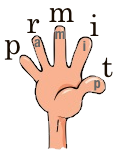
For the plucking hand, in fingerstyle, the Spanish, Latin classical names and what are commonly used in English are shown.
- Thumb ( t ), not really a finger but a digit. In classical guitar notation this is Pulgar (p), Pollex (p)
- Index ( i ) finger. In classical guitar notation Indice, Index (i)
- Middle ( m ) finger. In classical guitar notation Medio, Medius (m)
- Ring ( r ) finger. In classical guitar notation Anular, Aanularius (a)
- Pinky ( p ) finger. In classical guitar notation Mignolo (c, x or e)
Spanish: p i m a, English: t i m r
If you're studying traditional classical guitar repertoire and technique, the classical terms for the right hand are more common. For all else I recommend simply using the English terms and eliminate an translation.
Modern Classical Guitar , the repertoire and technique dates back to the mid nineteenth century ( 1800s ). And offers a wealth of information that can be adapted to the ukulele. Which is essentially a small classical guitar in its construction and technique when played without a plectrum (pick).
When playing ukulele it's only four strings with each finger handling their own string. On ukulele it's a simple finger to string assignment, your thumb handles string ④, your index finger handles string ③, your middle finger handles string ② and your ring finger handles string ①. A simple one-to-one string assignment.

Unlike ukulele with only one set of four strings, With the guitar there are fifteen possible four string combinations, not all are practical but a lot more than the one for ukulele.
When playing any of the three, possible three Ukulele String Sets . You can use the thumb, index and middle fingers.
For the two Ukulele String Pairs any combination of t i m r is possible depending on the musical context.
The final decision as to what fingering combination to use will be a musical one. But it is definitely worth exploring all possible combinations.
The Fingerpicking Series of Lessons explores these fingering possibilities.
My Personal Journey Exploring the Classical p i m a
Fingerstyle
So, one day I decided to finally get a handle on Classical p i m a
Fingerstyle using my thumb and three fingers. I had developed my Travis Picking
fingerpicking style, where you use your thumb, index and middle fingers. But not legit
a.k.a. classical p i m a
fingerstyle.
It was a dark stormy night
Don't all stories begin like that? It actually was a dark stormy night, an approaching hurricane coming up the Atlantic Ocean on the Northeast coast of the USA<.
I had, on a good day, a 30 to 45-minute drive home from that night's teaching as a music store. With many of the normal routes I'd typically take home, I'd have to take a different way home. It actually came closer to 90 minutes to get home using back and side roads.
So, it was during that long drive home on that dark stormy night that I practiced, p i m a
, my Thumb, Index, Middle and Ring finger technique on the open strings of my Fluke ukulele, which was riding shotgun right up front with me. It yelled shotgun coming out of the store. No chords as the left hand was busy driving – I only did p i m a with the right hand for one hour plus. I focused on getting a clean sound, even volume and tone. Starting S L O W and only after many reps did I increase the tempo. I only did that one drill for the whole ride, no other combinations. I then practiced accenting one of the strings in the sequence. t i m r, t i m r, t i m r, t i m r.
String Combinations
One Finger, Single String
You only have your thumb and three fingers to master. The pinky is seldom used - especially on the ukulele with only four strings where all fingerpicking patters can be handled by the thumb and the other three fingers.
- t - thumb
- i - index
- m - middle
- r - right
Two Finger, Single String Combinations
There are twelve 12 possible two finger, single string combinations.

Example starting on the thumb ( t ), C tuning with a high G string four.
- t i
- t m
- t r
- i t
- i m
- i r
- m t
- m i
- m r
- r t
- r i
- r m
Three Finger, Single String Combinations
There are twenty-four 24 possible three finger, single string combinations.
- t i m
- t i r
- t m i
- t m r
- t r i
- t r m
- i t m
- i t r
- i m t
- i m r
- i r t
- i r m
- m t i
- m t r
- m i t
- m i r
- m r t
- m r i
- r t i
- r t m
- r i t
- r i m
- r m t
- r m i
Four Finger, Single String Combinations
There are twenty-four 24 possible four finger, single string combinations.
- t i m r
- t i r m
- t m i r
- t m r i
- t r i m
- t r m i
- i t m r
- i t r m
- i m t r
- i m r t
- i r t m
- i r m t
- m t i t
- m t r i
- m i t r
- m i r t
- m r t i
- m r i t
- r t i m
- r t m i
- r i t m
- r i m t
- r m t i
- r m i t
Checkout the below video demonstrating all the combinations starting in the thumb (t).
What About the Pinky?
Funny you should ask. The pinky is typically not used in fingerstyle. With the ukulele only having four strings, the thumb and three fingers are enough to handle only four strings.
Practical Applications
For all practical purposes, single string fingerpicking can be mostly done with your thumb, index and middle fingers or a combination of the same fingers.
Classical Guitar Links & Information
There are several schools of though with regards to classical fingerstyle. Here is a collection of and information I've been collecting during my research in to fingerstyle as applied to the ukulele.
- WidipediA: Classical guitar technique
The classical guitar technique is a fingerstyle technique used by classical guitarists to play classical guitar music on a classical guitar.
- WidipediA: Fingerstyle guitar
Fingerstyle guitar is the technique of playing the guitar by plucking the strings directly with the fingertips, fingernails, or picks attached to fingers, as opposed to flatpicking (picking individual notes with a single plectrum called a flatpick) or strumming all the strings of the instrument in chords. The term is often used synonymously with fingerpicking (although fingerpicking can also refer to a specific stylistic subset; see below). Music arranged for fingerstyle playing can include chords, arpeggios and other elements such as artificial harmonics, hammering on and pulling off with the fretting hand, using the body of the guitar percussively, and many other techniques.
- WidipediA: Hybrid picking
Hybrid picking is a guitar-playing technique that involves picking with a pick and one or more fingers alternately or simultaneously. Hybrid picking allows guitar players who use a pick (plectrum) to perform music which would normally require fingerstyle playing. It also facilitates wide string leaps (e.g. from the sixth string to the second string, etc) which might otherwise be quite difficult. The technique is not widespread in most genres of guitar playing (though notable exceptions exist), but is most often employed by country and bluegrass flatpickers who play music which occasionally demands fingerstyle passages.
- Tuck's Corner, Tuck Andress (1/99 - updated 8/24/99) Pick & Fingerstyle Technique
For fingerstyle Tuck goes over; Development of fingerstyle, The fundamentals of fingerstyle technique according to Tuck, Choosing which finger to use when playing single lines, How to use picking to improve fingerstyle
- Great Tone By Michael Chapdelaine
This is a great article on the benefits of developing string contact with the fleshy part of the finger before the nail. Explains why getting a good sound on nylon strings with a pick is so hard to develop.
- Great Tone By Rest Stroke and Free Stroke Revisited, Published: 1990 Author: Ricardo Iznaola
Nails or No Nails
The use of the nails of the right hand has been debated over the years starting with Fernando Sor who found the use of nails to be unnecessary. While his contemporary Dionisio Aguado felt that the nails were necessary to achieve speed and tonal variation. From Andres Segovia onwards the nail in conjunction with the flesh of the right hand fingers has become the accepted practice.
Nail Care
Regular and proper care of your nails is the single, foremost way to prevent them from breaking and requiring repair.(Everyday)
Links & Information From Around the Web
- Acrylic Nails - link
- Flamenco Guitarist Nails - Tips and Advice - link
- The Art of Nail Care By Jason Fowler - link
- Care of the Nails (guitardownunder.com) - link
Nail Care Tools
- Diamond File
- 500 Grade Sandpaper
- 600 Grade Silicon Carbide - available at hardware stores
- Multigrade Cosmetic Nail Buffer or 800 Grade paper for buffing the nail
Nail Care Products

Nail making and repair kit, includes: band of self adhesive silk, 2 tubes of resin, Nail file, needle and applicator stick.
Andrés Segovia
You can not have a web site with a classical guitar page and not have mention of the Andrés Segovia. Segovia IS responsible for the recognition that the classical guitar has today.
 Andrés Torres Segovia, marqués de Salobreña (February 21, 1893 – June 3, 1987) was a Spanish classical guitarist, and later nobleman, born in Linares, Spain who is considered to be the father of the modern classical guitar movement by most modern music scholars. Segovia claimed that he "rescued the guitar from the hands of flamenco gypsies," and built up a classical repertoire to give it a place in concert halls. In recognition of his contributions to music and the arts, Segovia was ennobled June 24th, 1981 by the King of Spain (S.M. el rey Juan Carlos) who elevated Segovia into the first hereditary marquess of Salobreña, (formally styled, "El señor don Andrés Torres Segovia, marqués de Salobreña", i.e. the Most Illus. Lord The Marquess of Salobreña.) with the following coat of arms: "en campo de azur sobre ondas de azur y plata, unas rocas de su color, sumadas de una torre donjonada de oro, aclarada de azur."
Andrés Torres Segovia, marqués de Salobreña (February 21, 1893 – June 3, 1987) was a Spanish classical guitarist, and later nobleman, born in Linares, Spain who is considered to be the father of the modern classical guitar movement by most modern music scholars. Segovia claimed that he "rescued the guitar from the hands of flamenco gypsies," and built up a classical repertoire to give it a place in concert halls. In recognition of his contributions to music and the arts, Segovia was ennobled June 24th, 1981 by the King of Spain (S.M. el rey Juan Carlos) who elevated Segovia into the first hereditary marquess of Salobreña, (formally styled, "El señor don Andrés Torres Segovia, marqués de Salobreña", i.e. the Most Illus. Lord The Marquess of Salobreña.) with the following coat of arms: "en campo de azur sobre ondas de azur y plata, unas rocas de su color, sumadas de una torre donjonada de oro, aclarada de azur."
Andrés Segovia (1893-1987) is considered to be the father of the modern classical guitar movement by most modern scholars.
Without Segovia's efforts, the classical guitar would not be where it is today.
(from classicalguitar.net) - Segovia had many students throughout his career. Among the more famous are Christopher Parkening, John Williams, Elliot Fisk and Oscar Ghiglia. These students, along with the many others, carry on Segovia's tradition, while at the same time expanding the classical guitar's presence, repertoire, and musical boundaries.
For more information on Andrés Segovia check out these
- WikipediA
- The Segovia Museum
- classicalguitar.net - Andrés Segovia
- YouTube.com - link
Conclusion
There is of a lot of work to do — but it's well worth the effort.
So get to work!!!
Related Lessons, Videos, Lesson Series, Songs, Books & Reference Charts, Resources & Assets, Workshops are below.
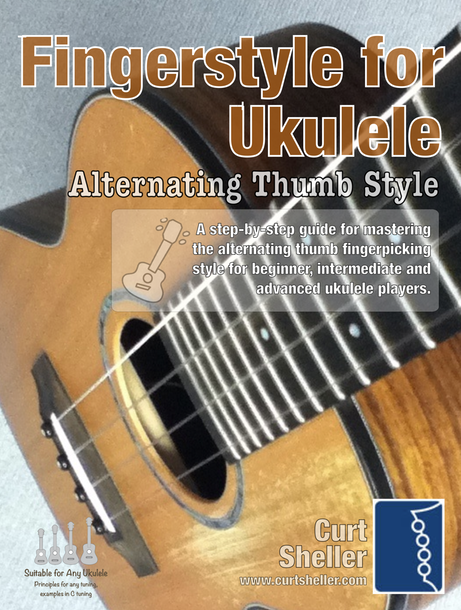
There are two common styles of fingerpicking on ukulele. This series of lessons explores the Alternating Thumb Style. A future series will explore the Thumb and three finger style, the traditional p i m a classical guitar style that we’ll adapt to ukulele.

"Modular Phonetic Rhythm" by Chuck Anderson represents a significant advance in the teaching and application of rhythm. Eliminating many inefficient aspects of rhythm education, Modular Phonetic Rhythm streamlines the traditional educational approach, resulting in a reflexive reaction to rhythm. This approach is applicable to all ages and to all styles of music.
Fingerstyle Basics for `Ukulele - t i m r, ( p i m a ).

Modular Phonetic Rhythm represents a significant advance in the teaching and application of rhythm. Eliminating many inefficient aspects of rhythm education, Modular Phonetic Rhythm streamlines the traditional educational approach, resulting in a reflexive reaction to rhythm.
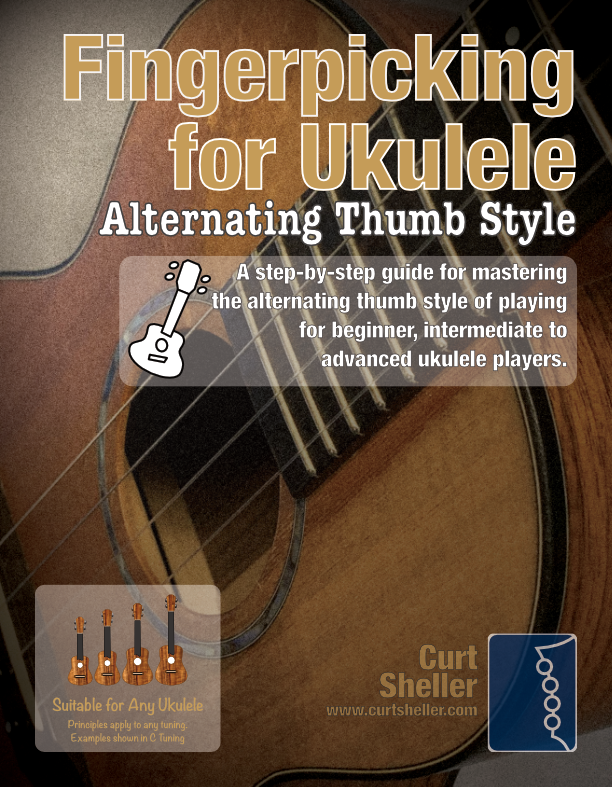
Fingerpicking for Ukulele - Alternating Thumb Style, 2nd Edition is a new expanded edition that focuses on the alternating thumb fingerpicking style through a series of graduated lessons-chapters incorporating your index and middle fingers with the alternating thumb.
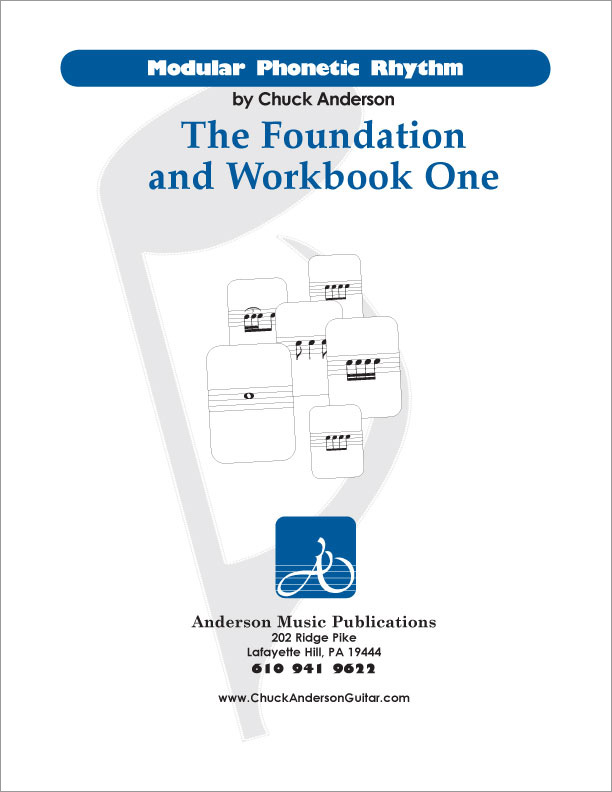
Modular Phonetic Rhythm represents a significant advance in the teaching and application of rhythm. Eliminating many inefficient aspects of rhythm education, Modular Phonetic Rhythm streamlines the traditional educational approach, resulting in a reflexive reaction to rhythm.

Finally, learn the names of the notes of the ukulele fingerboard in C tuning .

Learn the six fingering principles to navigating the ukulele fingerboard. Fingering is one of the most universal topics. Book: Six Secrets of the Ukulele Fingering

Harmonic Analysis is the understanding of the functional sequence of chords. It is the process used to analyze the harmonic structure of a progression, song or composition. Book: Harmonic Analysis for Scale Selection and Chord Substitution

Learn to read single note melodies in the first/open position is a lot easier than you might think. Book: Ukulele – Reading Music Series – Primer

An organized collection of daily practice and reference material for the contemporary ukulele player for developing the vocabulary and knowledge necessary for single note playing. Book: Daily Practice Material for the Contemporary Ukulele
Checkout the Books & Reference Charts for additional Handy, Dandy Reference Charts.

Ukulele Fingerboard Chart for C Tuning, Low or High G – G C E A

Ukulele Fingerboard Chart for G Tuning, Low or High A – D G B E

A handy reference chart of all 15 major and relative minor key signatures. US Letter 8.5 x 11 sized (ANSI-A), A4
Checkout the Books & Reference Charts for additional Handy, Dandy Reference Charts.



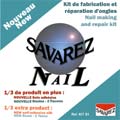


.jpg)